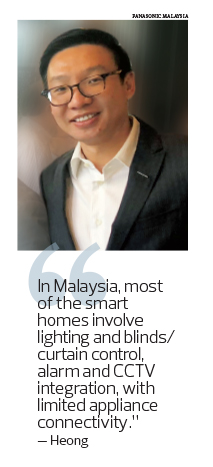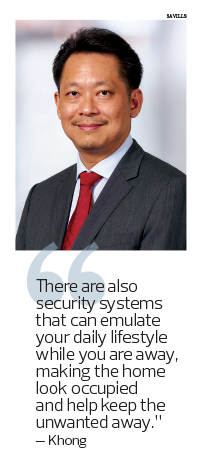
With more time being spent at home, it is natural that the use of smart devices has increased
This article first appeared in City & Country, The Edge Malaysia Weekly on July 18, 2022 - July 24, 2022
Interest in smart homes has increased as they are changing the way we live in a positive way. Technology plays a key role in home automation, which can free up time and, in some cases, help save money. What is a smart home and how does it work?
According to Samsung Malaysia Electronics Sdn Bhd head of consumer electronics Jimmy Tan, the whole idea behind smart home technology is to bring convenience and comfort into one’s home, making everyday life easier for the entire family. It also provides a more seamless experience for users when it comes to the appliances they own.
“With a few taps on one’s mobile device or tablet, one can easily control, sync, schedule or navigate the home appliances. This is evident in artificial intelligence-powered automation, where consumer behaviour is analysed to anticipate users’ usage patterns to suit their lifestyle,” he says.
With more time being spent at home, it is natural that the use of smart devices has increased, says Tan. The change in lifestyle during the Covid-19 pandemic, with everything being done at home, is one of the contributors. There has definitely been an increase in demand when it comes to smart home living, where residents seek more comfort, protection and control as well as a lifestyle that makes life easier, more efficient and effortless.
Adrian Heong Peng Wei, senior manager for strategic business to business development at Panasonic Malaysia Sdn Bhd, reckons that in the pre-pandemic era, a smart home was more a want than a need, where people could control everything from lighting to blinds/curtains and electrical appliances from the palm of their hands.
“Since the pandemic, however, smart technologies are being geared towards the wellness aspect. For instance, one can opt for an air circulation system that automatically controls humidity and temperature in each room, or have the lighting system and air conditioning synchronised to optimise sleeping conditions and facilitate natural waking,” he says.
Savills Malaysia Sdn Bhd managing director Datuk Paul Khong concurs, saying that the pandemic has helped quicken the pace and adoption of technological advancements. A good smart home will improve the performance of home appliances by providing both comfort and convenience. It allows the control of home devices from any location, ultimately increasing home security and energy efficiency.
Millennials continue to place a high value on technology and tend to pay more for homes or rental properties that include linked home devices. “Keyless access, voice-activated living, one-touch ambience management and self-learning technologies are some tools that facilitate our daily habits. Smart home technology has been introduced in several residential projects, including Gamuda Land’s Gamuda Cove in the southern Klang Valley, OSK Property’s Ryan & Miho in Petaling Jaya and IJM Land Bhd’s Swans @ Bandar Rimbayu in Selangor,” says Khong.
IOI Properties Group Bhd has introduced the IOISmartHome at some of its residential projects, including Almyra Residence and Palmyra Residence in Bandar Puteri Bangi, Sky Condominium in Bandar Puteri Puchong, Zentro Residences in Puchong South and Conezion Residences in IOI Resort City, Putrajaya.
“The features include a wireless smart switch, customisable scenes, smart switch, voice assistant, door/window motion sensor, an alarm system and remote system to control all the infrared (IR) remote devices in one application. More is expected from the smart home angle in future developments, especially with the presence of 5G capability,” he says.
Khong observes that in many countries, house evaluations usually include the availability of smart home systems with intelligent features, comprising smart thermostats, smart smoke alarms and home security system as a value-added item. Similarly, this will be the case in Malaysia for smart home features. It is something good to have but may not be a necessity due to the high installation and device costs. Nevertheless, it will soon be a norm with more demanding such features, he reckons.
He adds that the cost of setting up a proper smart home system is usually more than RM10,000. So, homeowners who have the budget may choose to upgrade to such systems.
Meanwhile, Tan says that whether people are willing to spend money on making their homes smarter depends on their personal preference. Consumers can start small by opting for a few appliances when they are dipping their toe into smart living. There is a wide range available and Samsung has various affordable and premium options, depending on what consumers are looking for.
“Our bespoke line-up gives customers the opportunity to design and match their home appliances to the interior of their homes. Some of our products that help to create a smart home include air purifiers, air conditioners, refrigerators, AI-powered robot vacuums, washers, dryers, televisions and soundbars,” he adds.
Heong says one can also DIY by adding relays, smart switches or plugs for connectivity that is normally one-way communication with simple functions like an on/off switch or a timer. “If you want a more advanced system, you will need to get smart-enabled appliances with built-in wireless capabilities. These products will allow more functions to be automated and monitored. In Malaysia, most of the smart homes involve lighting and blinds/curtain control, alarm and CCTV integration, with limited appliance connectivity.”
He notes that most of the smart home technologies are centred around the Internet of Things (IoT), which are either those with proprietary protocols that limit interoperability or those that are open source and are unregulated, which are unreliable and insecure. Most wireless systems use Zigbee, Z-Wave or WiFi technologies. For instance, many Panasonic smart appliances, like the Nanoe-x air conditioner and smart ceiling fans, come with built-in WiFi.
Advantages and disadvantages
According to Khong, smart home systems, when used correctly, can make life easier for homeowners. The ability to control everything remotely, from the heating to the curtains, means that they can check on the property when they are away or even at home from the sofa.
Faced with a market of increasingly savvy tenants, a well-equipped property can stand out from the crowd. “There is always growing demand for newer and more sophisticated products like iPhones. There are also security systems that can emulate your daily lifestyle while you are away, making the home look occupied and help keep the unwanted away,” he says.
Tan notes that scene customisation will allow users to create their own personalised settings based on their daily schedule. For example, there can be various settings on the air purifier during the day or one can select a custom setting for the lighting on movie night with one’s family.
“A smart home is great for those who are busy and like to multitask, as you can control the power of your devices, such as switching on and off the air conditioner or washing machine, when you are rushing out via the smartphone. This will ultimately give you peace of mind, so you can leave home without any worries. It also provides security, making it easier for you to track your items,” he says.
The downside to a smart home living, however, is that it depends on the internet. “Without a connection, users have limited or no access to their appliances. The appliances must be connected to the WiFi for the smart features to be fully utilised,” says Tan, adding that cybersecurity is another concern.
Khong points out that smart home systems often need constant updating and maintenance and can potentially prove costly for people. “Technological obsolescence is generally high, as newer products continue to flood the market, where newer and better upgrades are readily available and evolving. Also, tools are only as good as their operators and systems that are too complex can be a problem if homeowners are unable to work them properly.”
Advice for homeowners
Given all the smart home functions, Khong says it is unquestionably a good decision to invest in this technology. Many developers are promoting smart homes features that align with homeowners’ interests as it creates a safer home environment.
By automating selected functions, a smart home can be helpful to the elderly and disabled. “This may involve turning off the water before the tub overflows, sending medical reminders or even turning off the stove if someone goes missing for too long. Some of these gadgets can save lives by detecting natural gas and smoke, watching for unusual motions or keeping a close eye on the temperature in the kitchen,” he says.
Tan advises users to create an ecosystem where appliances and devices work together seamlessly for a better home experience. Hence, it requires a little planning on the user’s end, depending on personal needs and preferences.
“You can also work with your interior designer or contractor if you are designing your home from the ground up. Also, since WiFi is essential for any smart appliances to work, make sure you get enough coverage throughout your house to fully utilise smart functions,” he says.
“Consequently, it will be necessary to integrate smart home living into one’s lifestyle in the future with advancements in smart products. This is expected to go beyond home settings and be integrated into office spaces, restaurants and healthcare facilities.”
Save by subscribing to us for your print and/or digital copy.
P/S: The Edge is also available on Apple's App Store and Android's Google Play.
- Tan Kean Soon steps down as T7 Global executive deputy chairman, board says no operational impact
- China's Xi to visit Malaysia in April, SCMP reports
- Report on fatal Titiwangsa LRT accident submitted to MOT, says Prasarana
- France's Le Pen barred from running for office for five years after graft conviction
- Trump family to launch US bitcoin mining venture with Hut 8




